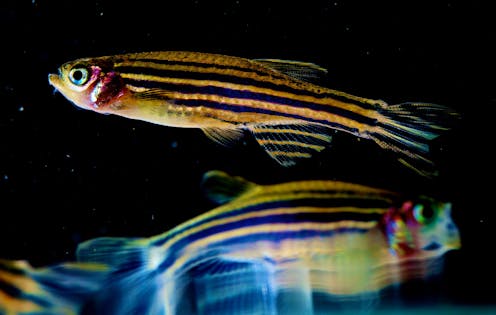Zebrafish are a scientist's favorite for early-stage research – especially to study human blood disorders
- Written by Gabrielle Dubansky, Master's Candidate in Molecular, Cellular and Developmental Biology, Iowa State University

Scientists have relied on animal models[1] as an alternative to testing on human tissues and cells for decades. But not just any organism can adequately model how human cells behave. Researchers take into account how quickly the organism can mature, how many offspring it can produce and how often it can reproduce. When studying genetics and developmental biology, one of the most important qualities to consider is how similar the model organism’s genes are to human genes.
Although humans and fish certainly look very different, the zebrafish has proved to be an excellent model organism for scientists studying hematopoiesis[2], or the development of blood cells.
In the Espín Lab[3] at Iowa State University, we study[4] the early stages of blood development, particularly the birth of blood stem cells, which happens only once during embryonic development. We focus on a specific set of genes that play a significant but somewhat elusive role in the molecular pathways involved in this process. Although we want to understand how these genes work in the context of human blood development, testing on human embryos is obviously ethically impossible. To circumvent these challenges, we use zebrafish instead.
Zebrafish as a model organism
Zebrafish have several traits that make them excellent model organisms.
For one, one female zebrafish can produce hundreds of embryos per week[6]. This is important to scientists because having larger sample numbers strengthens the accuracy of the data they collect in their experiments.
Zebrafish embryos are also able to develop quickly. One day of development in zebrafish is equivalent to approximately 90 days of human development. This means that researchers can save time and observe the different stages of development much sooner than with other organisms.
This time-lapse video shows the first 22 hours of zebrafish development after fertilization, with blood vessels labeled green. Blood has already formed at this stage of development.Another useful quality of zebrafish is that they are translucent during early development[7]. As soon as their embryos are fertilized, scientists can observe cells and tissues form and clearly see the effects of modifying different genes.
Perhaps the most important feature of zebrafish for scientists is their genetic makeup. Approximately 70% of zebrafish genes[8] have similar analogs in people, allowing researchers to study how certain genes work.
Studying blood disorders with zebrafish
Beyond sharing a significant percentage of genes with people, zebrafish are especially useful to blood development research because they produce the same types of blood cells[9]. Just like people, zebrafish have erythroid[10], lymphoid[11] and myeloid[12] cell types that are responsible for numerous roles in the body, like circulating oxygen and regulating inflammation and immunity. Mature blood cells are derived from blood stem cells. Therefore, studying how these stem cells are made would aid in developing treatment for numerous blood disorders that rely on blood stem cell therapies, such as leukemia, lymphoma and anemia.
Labs like ours use zebrafish to study how specific cell signaling pathways contribute to the birth, development and maturation of these blood stem cells. This knowledge provides context for how healthy cells work and communicate, because cells rely on signals from other cells to know which genes they need to turn on to produce specific proteins and molecules.
For example, we have previously shown how inflammatory signaling pathways[13] are needed for zebrafish to properly develop the hematopoietic stem cells[14] that produce multiple kinds of blood cells. We are currently exploring how these inflammatory pathways produce human blood stem cells. While most cells receive certain signals that trigger them to express certain genes, stem cells[15] are capable of developing into multiple types of cells in an organism. Stem cells are undifferentiated, meaning that they are not yet limited to expressing or following only certain parts of the DNA like more mature, differentiated cells.
For patients with blood-related disorders like leukemia, there are currently limited treatment options. Bone marrow transplants[17] are among these options. But there is a shortage of matching donors, and the procedure can be risky because of graft-versus-host disease[18], in which the donor’s healthy immune cells attack the recipient’s body cells.
A possible solution is to use a special kind of stem cell called an induced pluripotent stem cell[19]. To make these cells, scientists use a special set of proteins called Yamanaka factors to turn on specific genes that revert a mature, differentiated cell into an immature, undifferentiated cell. From this point, the cells can be manipulated to express certain genes at specific times, told which part of their DNA to read or which signals to follow.
However, to properly direct these stem cells, researchers need a more complete understanding of the molecular signals involved and how they contribute to early blood development. To bridge these gaps, labs like ours rely on zebrafish to test their theories about the roles that certain genes and proteins play in development.
Model organisms like zebrafish are what allow scientists to get one step closer to solving real-world problems every day.
References
- ^ relied on animal models (doi.org)
- ^ hematopoiesis (doi.org)
- ^ Espín Lab (www.espinlab.com)
- ^ we study (scholar.google.com)
- ^ Ernesto del Aguila III/NHGRI via Flickr (flic.kr)
- ^ hundreds of embryos per week (doi.org)
- ^ translucent during early development (doi.org)
- ^ 70% of zebrafish genes (doi.org)
- ^ same types of blood cells (doi.org)
- ^ erythroid (doi.org)
- ^ lymphoid (doi.org)
- ^ myeloid (doi.org)
- ^ inflammatory signaling pathways (dx.doi.org)
- ^ hematopoietic stem cells (doi.org)
- ^ stem cells (theconversation.com)
- ^ Daniel Castranova/National Institute of Child Health and Human Development, NIH via Flickr (flic.kr)
- ^ Bone marrow transplants (theconversation.com)
- ^ graft-versus-host disease (www.cancerresearchuk.org)
- ^ induced pluripotent stem cell (doi.org)
Authors: Gabrielle Dubansky, Master's Candidate in Molecular, Cellular and Developmental Biology, Iowa State University

